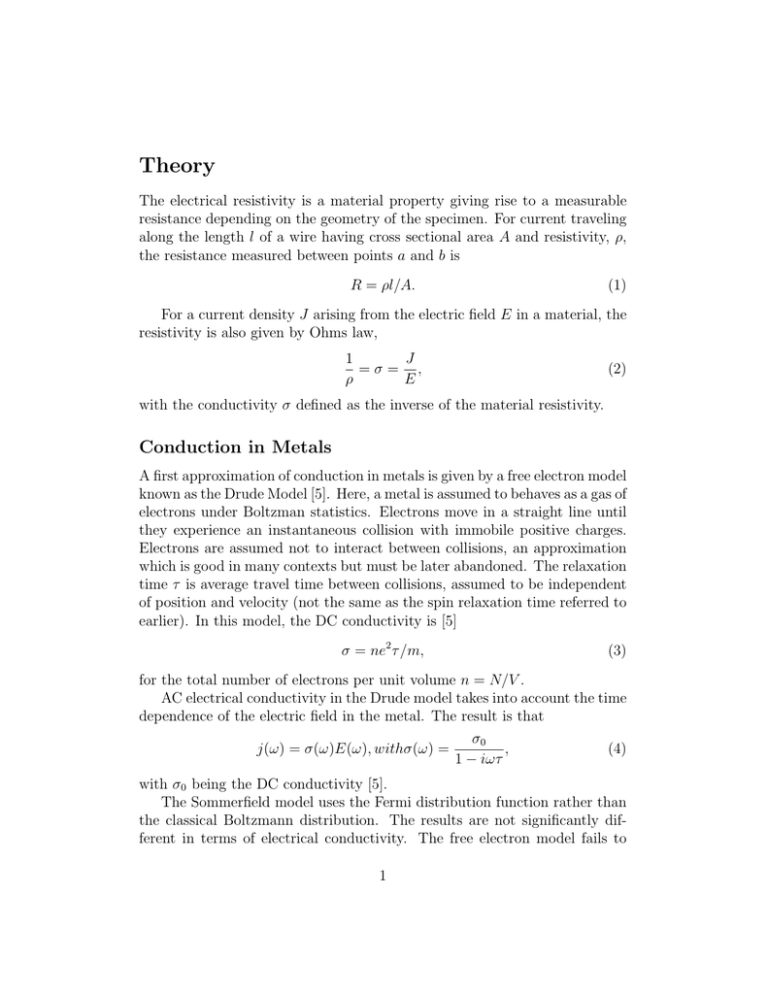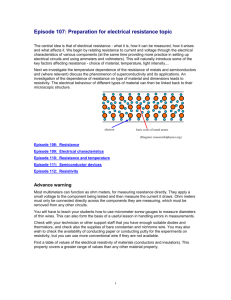Theory
advertisement

Theory The electrical resistivity is a material property giving rise to a measurable resistance depending on the geometry of the specimen. For current traveling along the length l of a wire having cross sectional area A and resistivity, ρ, the resistance measured between points a and b is R = ρl/A. (1) For a current density J arising from the electric field E in a material, the resistivity is also given by Ohms law, J 1 =σ= , ρ E (2) with the conductivity σ defined as the inverse of the material resistivity. Conduction in Metals A first approximation of conduction in metals is given by a free electron model known as the Drude Model [5]. Here, a metal is assumed to behaves as a gas of electrons under Boltzman statistics. Electrons move in a straight line until they experience an instantaneous collision with immobile positive charges. Electrons are assumed not to interact between collisions, an approximation which is good in many contexts but must be later abandoned. The relaxation time τ is average travel time between collisions, assumed to be independent of position and velocity (not the same as the spin relaxation time referred to earlier). In this model, the DC conductivity is [5] σ = ne2 τ /m, (3) for the total number of electrons per unit volume n = N/V . AC electrical conductivity in the Drude model takes into account the time dependence of the electric field in the metal. The result is that σ0 , (4) j(ω) = σ(ω)E(ω), withσ(ω) = 1 − iωτ with σ0 being the DC conductivity [5]. The Sommerfield model uses the Fermi distribution function rather than the classical Boltzmann distribution. The results are not significantly different in terms of electrical conductivity. The free electron model fails to 1 account for the temperature dependence conductivity. Also, directional dependence (orientation of specimen relative to field) is not accounted for in this theory[5]. Successively more complex models have been applied to the problem of metallic electrical conductivity. Electrical resistivity essentially arises from the scattering of electrons, and the relaxation time approximation is often used to evaluate the nonequilibrium distribution function describing electron motion and collisions. In a nonferromagnetic metal, the following forms of electron scattering occur: [5] • Electrons scatter from crystal defects and impurities. This so called intrinsic contribution is essentially constant and dominates the resistivity at low (near liquid helium) temperatures. • The dominant room temperature contribution is deviation of the ionic network from perfect periodicity due to vibrations of lattice ions, known as phonons. This is the most important source of temperature dependence in DC resistivity and usually dominates at room temperature. Matthiessen’s rule states that individual contributions to the resistivity add linearly, ρT otal = ρ1 + ρ2 . (5) This is valid in the relaxation time approximation; otherwise the total resistivity may be greater than the sum of the contributing resistivities. Consider the phonon contribution. Phonon statistics are characterized by a limit in the number of vibrational modes available to the lattice ions. In the calculation of average phonon energy, this gives rise to a value the Debye temperature ΘD defined as [6] Θ = (h̄ν/kb )(6πn)1/3 (6) At high temperatures, total number of phonons in a mode is given by the Plank distribution, kb T (7) n(q) ≈ h̄ω(q) for phonon wave vector q. With the number of phonon scatterers increasing linearly with T , so does the resistivity, ρ ∝ T, T >> ΘD . 2 (8) For T well below ΘD ), the net electron-phonon scattering can be shown [5] to decline as T 3 . However, as the temperature lowers, the phonons have less energy and are less able to change the velocity of the electron, and scattering becomes more concentrated in a forward direction. At sufficiently low temperatures, phonon scattering is very nearly elastic, introducing a T 2 term [5]. The resulting dependence is known as the Bloch T 5 law, p ∼ T 5 , T << ΘD . (9) The Debye temperature, ΘD , for Iron is around 400 K [1]. Behavior near and above this temperature will not be observed in this experiment. It is also worthwhile to point out that the value of the Debye given by resistivity measurements need not agree with value obtained in heat capacity measurements [7]. Conduction in Ferromagnetic Metals In ferromagnetic metals, another important contribution to the resistivity is due to electron scattering from the quantized precession of the spins of localized s and d electrons, or spin waves. An important explanation of the spin wave scattering was made by D. A. Goodings, taking experimental results into consideration [3]. In a ferromagnetic transition metal such as iron, the s and d bands overlap at the Fermi energy, thus scattering may take place within a single energy band or it may involved s − d transitions. The contribution to electrical resistivity of the exchange interaction between conduction electrons and the localized magnetic electrons (s − d or s − f ) has been demonstrated [8] and shown to be proportional to T 2 [9]. References [1] G.K White and S.B. Woods. “Electrical and thermal resistivity of the transition elements at low temperatures.” Philosophical Transactions of the Royal Society of London. Series A, Mathematical and Physical Sciences., Vol. 251, No. 995. (Mar. 12, 1959), pp. 273-302. [2] E. Kondorsky, O. S. Galina, and L.A Tchernikov. “Nature of Electrical Resistivity of the Ferromagnetic Metals at Low Temperatures.” J. Applied Phys, 29, 3,March 1958. 3 [3] D. A. Goodings. “Electrical Resistivity of Ferromagnetic Metals at Low Temperatures.” Phys Rev 132, 2, 1963. [4] E. Dan Dahlberg. Distinguished Professor, Magnetic Microscopy Center, University of Minnesota. Private Conversation. [5] Neil W. Ashcroft, N. David Mermin. Solid State Physics. Suanders College 1976. [6] Charles Kittel, Herbert Kroemer. Thermal Physics, 2nd Ed. W. H. Freeman and Company, New York, 1980. [7] C. Kittel. Intro to Solid State Physics, 5th Ed. John Wiley & Sons, Inc, New York, NY 1976. [8] S.V. Vonsovski, Zh. Eksperim. i Teor. Fiz 18, 219 (1948) [9] E. A. Turov, Izv. Akad. Nauk SSSR, Ser. Fiz. 19, 426 (1955). [10] José Costa-Kramer. Visiting Professor, Magnetic Microscopy Center, University of Minnesota. Private Conversation. [11] G. R. Taylor, Acar Isin, R. V. Coleman. “Resistivity of Iron as a Function of Temperature and Magnetization.”Physical Review. 165, 2, January 1968. [12] J. Frhauf, F. Gnther. “On the current dependence of the residual electrical resistance of pure iron.” Physica Status Solidi., 23, 2, 1974. [13] CRC Handbook of Chemistry and Physics, 87th Edition, 2007. CRC Press. Accessed online ¡http://www.hbcpnetbase.com/¿ 2/16/2007. [14] Vuillemin. J J. and Khellaf. “The resistivity in high-quality single-crystal palladium” J. Phys.: Condens. Matter 4 (1992) 1757-1762. 4







